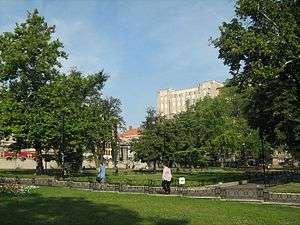Academy Park
| Academy Park | |
|---|---|
| (Serbian: Академски парк) | |
|
IUCN category III (natural monument or feature) | |
|
Academy Park | |
 Academy Park | |
| Location |
Stari Grad, Belgrade |
| Nearest city | Belgrade |
| Coordinates | 44°49′10″N 20°27′29″E / 44.819471°N 20.457958°ECoordinates: 44°49′10″N 20°27′29″E / 44.819471°N 20.457958°E |
| Area | 1.45 ha (3.6 acres) |
| Established | 2007 |
| Academy Park | |
Academy Park (Serbian Cyrillic: Академски парк) is a park in Belgrade, the capital of Serbia. It is situated in the neighborhood of Studentski Trg, in the downtown. It is located in Belgrade's municipality of Stari Grad. Built from 1886 to 1889, Academy Park is one of the oldest parks in Belgrade.[1]
Location
Academy Park is located halfway between the Republic Square (to the east) and the Belgrade Fortress (to the west). It is completely encircled by Studentski Trg, which is effectively turned into the four streets around the park.
Names
When formed, the park was called "Little Park" (Mali park) and later was renamed to "Pančić's Park" (Pančićev park). Today, it is officially named Academy Park,[2] but colloquially it is also called "University Park" (Univerzitetski park) and "Students' Park" (Studentski park).
History
Northern section of the park was excavated in 1968 in the project of building a furnace oil tank for the boiler room of the Belgrade's City Committee of the League of Communists located nearby. Under the lawn, the remnants of the ancient Roman thermae were discovered, including the frigidarium (room with the cold water), laconicum (room with the warm water) and caldarium (room with the two pools of hot water). Remains of the brick furnace were also found. It was a public unisex bath. The remnants were visible until 1978 and due to the lack of funds to continue excavations or to cover it with the roof or a marquee, the remains were conserved and buried again.[3]
Area of the park and the square surrounding it used to be a Turkish cemetery. At the beginning of the 19th century, farmers were selling goods at the entrances to the city. However, Turkish soldiers would often forcibly buy goods from them at the small prices, and then sell it themselves in the city for much higher amounts. After constant complaints from the farmers, vizier of Belgrade, after counseling with the city merchants, agreed to choose one place for the market. Market became operational in the 1820s. As per Serbian-Turkish agreement anyone could bring and sell goods, market quickly grew and became city's commercial center and was known as the Great Market (Serbian: Velika pijaca or Veliki pijac). Remaining , smaller part of Turkish cemetery, which was functional until the 1860s, was fenced by the local Turks to prevent further deterioration. After Turks completely withdrew from Belgrade and Serbia in 1867, the cemetery became overgrown with grass and was turned into the meadow, called "Little field" (Poljanče) by the local population. First modern Belgrade's urbanist Emilijan Josimović suggested dislocation of the market in 1867, as it was placed in the sole center of the city. He envisioned the social center or pedestrian square ("piazza") in the form of the park with tall deciduous trees instead.[2][4][5]
However, only the open space area around the market, was turned into the park which was named Little Park. Original park was constructed from the spring of 1886 to 1889. In 1897, a monument dedicated to the botanist Josif Pančič was erected in the park. It was the first such monument in Belgrade, and the park was soon renamed to Pančič's Park. The market continued to operate until 1926 when was finally closed and its area was used to enlarge the Pančič's park in 1927. The project was done by Đorđe Kovalevski. In 1929, a rococo stone ornamental fence with the massive gates made of wrought iron was built around the park, projected by Milutin Borisavljević. The fence and the gates cost seven time more than the construction of the enlarged park itself two years ago. In 1930, the monument dedicated to Dositej Obradović was transferred to the park from his previous location at the end of the Knez Mihailova street. A monument to Jovan Cvijić was dedicated in 1994.[2][3][4]
Characteristics
The park covers an area of 1.45 hectares (3.6 acres). In 2007 it was declared the natural monument.[1][2]
It was renovated in 2011-12 and 2015. New plane trees, Callery pears and photinias were planted and three flower rondelles were restored around the three monuments (Pančić, Obradović, Cvijić).[1] In 2008, two species of bats lived in the park.[6]
Surrounding area is location of many educational and cultural institutions, thus the names (Academy/Students Park). They include:
- Rectorate of the University of Belgrade in the representative Captain Miša's Mansion;
- Faculty for Natural Sciences and Mathematics ( University of Belgrade);
- University of Belgrade Faculty of Philosophy;
- University of Belgrade Faculty of Philology;
- Kolarac Public University, with concert hall;
- Ethnographic museum;
- A monument to Petar II Petrović Njegoš;
References
- 1 2 3 Branka Vasiljević (11 May 2015), "Počela zamena starih i bolesnih stabala u Akademskom parku", Politika (in Serbian)
- 1 2 3 4 "Akademski park" (in Serbian). Javno komunalno preduzeće "Zelenilo-Beograd".
- 1 2 Branka Vasiljević (14 November 2011), "Počinje uređenje Akademskog parka", Politika (in Serbian)
- 1 2 D.J.S. (13 December 2014), "Pijace slave Svetog Andreja Prvozvanog", Politika (in Serbian), p. 15
- ↑ Dragan Perić (23 April 2017), "Šetnja pijacama i parkovima", Politika-Magazin No 1021 (in Serbian), pp. 28–29
- ↑ Branka Vasiljević (November 2008), "Prestonica - dom za sisare", Politika (in Serbian)
External links
| Wikimedia Commons has media related to Akademski park. |
